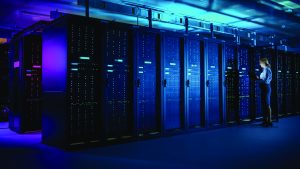In my last blog, I explore innovative approaches to address the workforce shortage in data center operation and maintenance. What I did not touch on was the concept of leveraging the existing workforce available in the market. Today, I would like to delve into the concept of labor workforce “uberization” and its potential impact on this topic.
Think about how Uber changed the taxi market when they created a platform to match a supply of labor (drivers) with consumer demand (riders). This helped create a virtualized shared labor force to help execute the work needed and to create opportunities for consumers in the market. If we could “Uberize” a workforce matching supply to demand, for electrification and power service needs, we could work together as an industry to solve the workforce shortage problem.
There is no doubt that in the coming years, industries are poised to face unprecedented challenges in designing, constructing, operating, and maintaining various infrastructures and buildings. The rapid evolution of technology and a shortage of skilled labor necessitates collaborative efforts and innovative thinking to keep pace with the transforming landscape.
As markets thrive and the workforce dwindles, a collaborative approach is crucial!

Shrinking Labor Supply
The fusion of Artificial Intelligence (AI) across businesses, surge in demand for real-time data access, electrification touching every facet from vehicles to buildings, and societal commitment to decarbonization are steering industries towards innovation. These changes not only require groundbreaking ideas but also demand a reimagining of service delivery in our digitized, electric world.
With the surge in AI and analytics as well as the necessity of real-time data streaming, we are seeing an exponential rise in data center construction. Part of this growth stems from AI’s reliance on high-performance computing which is fueling an increase in computing capacity. Further, the establishment of edge data centers in smaller markets to ensure universal data access contributes to data center proliferation, resulting in localized labor shortages. Concurrently, a looming global workforce shortage adds complexity, as experienced professionals are retiring, and younger generations are choosing alternative career paths.
Services Demand Growing
With data center expansions, modernization of commercial and industrial buildings, and the electrification of the residential market, the demand for service in the electrical, mechanical, and power sectors is skyrocketing. This significant growth of assets requiring attention in the field presents a significant service challenge for everyone.
Additionally, accelerated adoption of electrification and decarbonization strategies, spurred by regulations mandating these changes in buildings and homes, has transformed the market landscape. The demand for redesigned and modernized residential and commercial buildings to accommodate elevated power requirements is on the rise. Beyond talk, companies are actively decarbonizing their structures, which requires an overhaul of infrastructure with now mandatory maintenance of electrical equipment in accordance with the new NFPA 70B. This rapidly evolving electrical infrastructure will lead to a massive increase of on-site service work and customer interaction.
The “Uberization” Paradigm
Efforts to overcome the workforce challenge must encompass technology, innovation, and strategic initiatives. Industry stakeholders must collaborate to attract fresh talent, equip them with essential skills, and mold them for future roles. Imagine an industry collaboration where we shared our very valuable and skilled labor so we all benefit. At the same time, capturing the wisdom of experienced professionals before their exit is paramount. Leveraging AI tools to facilitate knowledge transfer to a younger generation is an invaluable strategy.
By creating a digital repository of skilled labor, and matching these experts with businesses in need, the industry can efficiently start to manage the workforce shortage. Manufacturers could offer training programs for partners, certifying them to undertake specific tasks on their assets. A digital platform could then connect businesses with certified technicians, streamlining service delivery. Leveraging the principles that transformed the taxi industry, an “Uberization” approach can revolutionize the electrical, mechanical, power, and digital industries. We have accomplished this in the consumer world, why not the business world?
Embracing Transformation: A Win-Win Scenario
The “Uberization” model promises mutual benefits. Certified partners gain increased business exposure, while businesses gain access to a diverse pool of skilled labor. This collaborative approach optimizes local labor resources and curtails unnecessary travel, promoting environmental sustainability. The successes of this model in other sectors underscore its potential for the electrical, mechanical, power, and digital realms.
The path to addressing the workforce crisis lies in innovative thinking and embracing change. By leveraging technological advancements and novel business models, the industry can efficiently allocate limited skilled resources and streamline operational services.
The journey to solving the skilled labor shortage conundrum requires a multifaceted approach, blending innovation, technology, and collaborative strategies, including the workforce “Uberization” model. While there’s no single solution, these elements hold the key to reshaping service delivery and ensuring a sustainable future for industries encompassing homes, plants, buildings, and data centers.
At Schneider Electric, we harness the power of the Qmerit digital platform (program piloting in Washington and Atlanta) to seamlessly connect our certified partners with customers who are eager to implement maintenance aligned with the latest requirements of the NFPA70B standard. This is just the beginning of this journey; we welcome you to join us in driving a transformation that benefits all.




